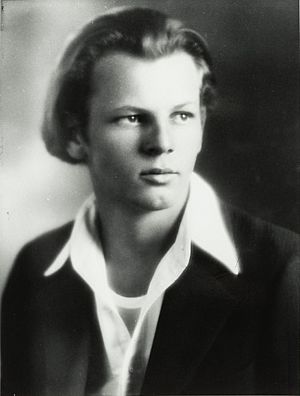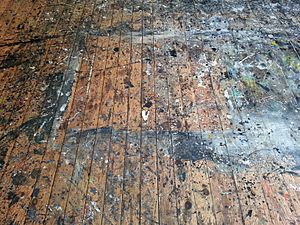Jackson Pollock facts for kids
Quick facts for kids
Jackson Pollock
|
|
|---|---|

Pollock, around 1928
|
|
| Born |
Paul Jackson Pollock
January 28, 1912 Cody, Wyoming, U.S.
|
| Died | August 11, 1956 (aged 44) Springs, New York, U.S.
|
| Education | Art Students League of New York |
| Known for | Painting |
|
Notable work
|
|
| Movement | Abstract expressionism |
| Spouse(s) | |
| Signature | |
 |
|
Paul Jackson Pollock (born January 28, 1912 – died August 11, 1956) was a famous American painter. He is best known for his special "drip technique." This is where he poured or splashed liquid paint onto a canvas laid flat on the floor. This way, he could paint from all sides. His style was also called "all-over painting" and "action painting" because he used his whole body to create art that covered the entire canvas.
Pollock's paintings are now in art museums around the world. His work is considered very important and valuable. Many movies have been made about his interesting life.
Contents
Early Life and Art Beginnings
Paul Jackson Pollock was born in Cody, Wyoming, in 1912. He was the youngest of five brothers. His parents, Stella May and LeRoy Pollock, were from Tingley, Iowa. His father worked as a farmer and later as a land surveyor. His mother, Stella, made and sold dresses. When Jackson was only 10 months old, his family moved to San Diego. He never went back to Cody. He grew up in places like Arizona and Chico, California.
Pollock went to Manual Arts High School in Los Angeles but was expelled. He had also been expelled from another high school in 1928. When he was young, he learned about Native American culture during trips with his father. He was also greatly inspired by Mexican mural painters, especially José Clemente Orozco. Pollock once called Orozco's fresco Prometheus "the greatest painting in North America."
In 1930, Pollock moved to New York City, following his older brother Charles Pollock. They both studied art at the Art Students League of New York with Thomas Hart Benton. Benton's style of painting rural American scenes did not influence Pollock much. However, Benton's way of using paint and his strong independence did stay with Pollock. In the early 1930s, Pollock traveled through the Western United States with Benton and another art student, Glen Rounds.
Becoming a Famous Artist
In 1936, Pollock learned about using liquid paint at a special workshop in New York City. This workshop was led by the Mexican muralist David Alfaro Siqueiros. That summer, Pollock also visited Dartmouth College to study a huge mural called “The Epic of American Civilization” by José Clemente Orozco. Pollock started using paint pouring as one of his techniques in the early 1940s. You can see this in paintings like Male and Female.
After he moved to Springs, New York, Pollock began to paint with his canvases on the floor. This is when he really developed his famous "drip" technique.
From 1938 to 1942, Pollock worked for the WPA Federal Art Project. This was a government program that helped artists during a difficult economic time.
In 1943, Pollock signed a contract with Peggy Guggenheim, an important art collector who supported many artists. She asked him to create a large painting, 8-by-20-foot (2.4 by 6.1 m), called Mural for her new home. Her friend, the artist Marcel Duchamp, suggested Pollock paint it on canvas so it could be moved. After seeing the big mural, art critic Clement Greenberg said, "I took one look at it and I thought, 'Now that's great art,' and I knew Jackson was the greatest painter this country had produced."
Pollock's Unique Drip Technique
Pollock's most famous paintings were made during his "drip period" between 1947 and 1950. By painting on a flat surface, he could walk around the canvas and apply paint from all directions. This added a new way of creating art.
He became very famous after an article about him appeared in Life magazine on August 8, 1949. The article asked, "Is he the greatest living painter in the United States?" At the height of his fame, Pollock suddenly stopped using his drip style.
Later Life and Legacy
On August 11, 1956, Pollock died in a car crash. His wife, Lee Krasner, was visiting friends in Europe at the time. She quickly returned home when she heard the sad news.
Four months after his death, in December 1956, a special exhibition of Pollock's work was held at the Museum of Modern Art (MoMA) in New York City. A larger show of his art happened there in 1967. In 1998 and 1999, his work was honored with big exhibitions at MoMA and at The Tate in London.
For the rest of her life, Lee Krasner made sure that Pollock's art and reputation remained strong. Jackson Pollock and Lee Krasner are buried in Green River Cemetery in Springs. A large rock marks his grave, and a smaller one marks hers.
Art Market Success
Pollock's paintings have sold for very high prices. In 1973, his painting Number 11, 1952 (also known as Blue Poles) was bought by the Australian government for US$2 million. At that time, it was the most expensive modern painting ever sold. Today, it is one of the most popular artworks at the National Gallery of Australia.
In November 2006, Pollock's No. 5, 1948 became the world's most expensive painting. It sold for about US$163.8 million dollars. Another one of his paintings, No. 12 (1949), sold for $11.7 million in 2004. In 2012, Number 28, 1951, sold for $20.5 million.
In 2013, Pollock's Number 19 (1948) sold for over $58 million at an auction. In February 2016, it was reported that Number 17A sold for $200 million.
The Pollock-Krasner House and Study Center is where Pollock and his wife lived and worked. It is now a museum run by Stony Brook University. You can take tours of the house and studio from May through October.
List of Major Works

- (1942) Male and Female Philadelphia Museum of Art
- (1942) Stenographic Figure Museum of Modern Art
- (1942) The Moon Woman Peggy Guggenheim Collection
- (1943) Mural University of Iowa Museum of Art
- (1943) The She-Wolf Museum of Modern Art
- (1943) Blue (Moby Dick) Ohara Museum of Art
- (1945) Night Mist Norton Museum of Art
- (1945) Troubled Queen Museum of Fine Arts, Boston
- (1946) Eyes in the Heat Peggy Guggenheim Collection, Venice
- (1946) The Key Art Institute of Chicago
- (1946) The Tea Cup Collection Frieder Burda
- (1946) Shimmering Substance, from The Sounds In The Grass Museum of Modern Art
- (1946) Free Form , MoMA
- (1947) Portrait of H.M. University of Iowa Museum of Art
- (1947) Full Fathom Five Museum of Modern Art
- (1947) Cathedral Dallas Museum of Art
- (1947) Enchanted Forest Peggy Guggenheim Collection
- (1947) Lucifer The Anderson Collection at Stanford University
- (1947) Sea Change Seattle Art Museum
- (1948) Painting
- (1948) Number 5 (4 ft x 8 ft) Private collection
- (1948) Number 8 Neuburger Museum at the State University of New York at Purchase
- (1948) Number 13A: Arabesque Yale University Art Gallery, New Haven, Connecticut
- (1948) Composition (White, Black, Blue and Red on White) New Orleans Museum of Art
- (1948) Summertime: Number 9A Tate Modern
- (1948) "Number 19"
- (1949) Number 1 Museum of Contemporary Art, Los Angeles
- (1949) Number 3 Hirshhorn Museum and Sculpture Garden, Washington, D.C.
- (1949) Number 10 Museum of Fine Arts, Boston
- (1949) Number 11 Indiana University Art Museum Bloomington, Indiana
- (1950) Number 1, 1950 (Lavender Mist) National Gallery of Art
- (1950) Mural on Indian red ground, 1950 Tehran Museum of Contemporary Art
- (1950) Autumn Rhythm (Number 30), 1950 Metropolitan Museum of Art
- (1950) Number 29, 1950 National Gallery of Canada
- (1950) Number 32, Kunstsammlung Nordrhein-Westfalen, Düsseldorf, BRD
- (1950) One: Number 31, 1950 Museum of Modern Art
- (1951) Number 7 National Gallery of Art
- (1951) Black and White (Number 6) San Francisco Museum of Modern Art
- (1952) Convergence Albright-Knox Art Gallery
- (1952) Blue Poles: No. 11, 1952 National Gallery of Australia
- (1952) Number 12, 1952 Governor Nelson A. Rockefeller Empire State Plaza Art Collection
- (1953) Portrait and a Dream Dallas Museum of Art
- (1953) Easter and the Totem The Museum of Modern Art
- (1953) Ocean Greyness Solomon R. Guggenheim Museum
- (1953) The Deep Centre Georges Pompidou
Images for kids
-
Pollock's studio in Springs, New York
See also
 In Spanish: Jackson Pollock para niños
In Spanish: Jackson Pollock para niños




